|
History Notes Chapter 4, Page 2 of 3 Strategic Shift: Korean War Sacrifices |
||||||||||||||||
| The RB-29 flew throughout the Korean peninsula in the early part of the war but was soon in trouble with the addition of MiG-15 aircraft into the air war. In November 1950, MiG’s jumped a flak-damaged 91st RB-29 near the Yalu river. In the ensuing aerial battle, the RB-29 rear gunner shot down one of the MiGs — the first MiG-15 shot down by a B-29 gunner. The RB-29 limped back to Johnson AB, Japan and five crewmen were killed when it crashed during landing. (4) The FEAF restricted RB-29’s from flying near the Yalu during daylight hours due to their vulnerability to the MiG-15s. A faster reconnaissance aircraft was required in theater. |
||||||||||||||||
| The immediate answer to the vulnerabilities of the RB-29’s was the modified RB-50 and jet-powered RB-45 aircraft. While RB-45 reconnaissance aircraft managed to outrun and outmaneuver MiG’s on numerous occasions, they too eventually became targets. Many of these early missions were escorted by fighter aircraft and an eventual shift was made to night operations. In these early years, flash bombs were dropped prior to the camera crews taking night photos. | ||||||||||||||||
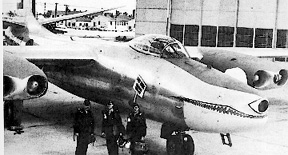 |
||||||||||||||||
|
from the 91st SRS at Yokota during 1953. (5) |
||||||||||||||||
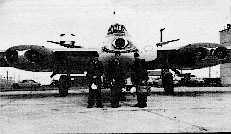 |
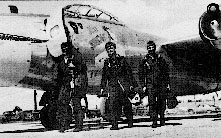 |
|||||||||||||||
| The 91st SRW was one of the first units to use aerial refueling aircraft in combat. On 29 July 1952, Major Louis Carrington flew a 91st SRW (Strategic Reconnaissance Wing) RB-45C on the first non-stop, transpacific flight and won the third Mackay Trophy ever presented. (6) Above, the “bloodshot” eye of RB-45C “No Sweat” seems to glare down on the crew that flew this award-winning flight. Major Carrington is shown on the right hand side of both photographs immediately after the 4,000 mile flight. (7) |
||||||||||||||||
 |
||||||||||||||||
|
from the 91st SRW assigned TDY to the 91st SRS, refuels an RF-84 over Korea. |
||||||||||||||||
| Throughout the Korean War, the 91st flew some unique missions in and out of the Far East theater. Overflights of Soviet-controlled Far East islands began in 1951. An example of this type of work was reconnaissance missions which were conducted over Karafuto following reports that the Soviets had built extensive underground installations and missile-launching facilities on the island. In Project 51, 91st SRW RB-45s took off from Yokota AB, Japan to conduct reconnaissance over the southern portions of Sakhalin Island. Photographic and radar reconnaissance overflight missions were also flown over the Murmansk-Kola inlet and Siberia. (8) | ||||||||||||||||
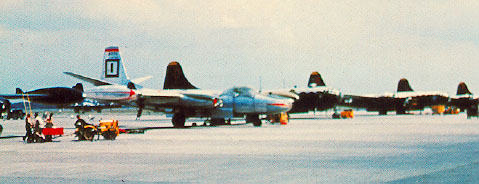 |
||||||||||||||||
| While operating from Yokota Air Base, the 91st SRW also had a detachment of RB-45C Tornados stationed at Sculthorpe, England. Only 33 RB-45s were ever built and the 91st SRW was the main operating unit for this ariframe. Other aircraft working from England were another detachments of RB-45s temporarily stationed at Manston AB, Kent; an RB-29 unit at Lakenheath and an RB-36 detachment stationed at Brize Norton. It was the later RB-36s which actually conducted reconnaissance flights which penetrated the western Soviet Union. (9) |
||||||||||||||||
|
of the 91st Strategic Reconnaissance Squadron at Johnson AFB, Japan. (10) Below: RB-45C, painted black to help avoid being detected by the North Korean searchlights, taxies out for takeoff at Yokota Air Base, Japan. (11) |
||||||||||||||||
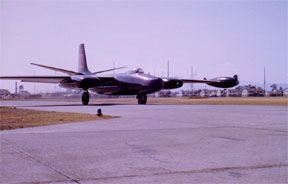 |
||||||||||||||||
| A Special Note For Clarification: When I joined the 91st SRS at Yokota in October 1953 as an RB-29 Aircraft Commander, one of my early impressions was that there was a cloak of secrecy regarding almost every element of our Squadron's operation. There were very few group meetings, an individual air crew had little interrelationship with any other crew, operational briefings were conducted primarily with individual crews with little or no cross feed with other crews, special mission aircraft would arrive and do their own thing without having contact with our regular complement of air crews. Obviously there were forces at work back in the US that were providing support for the many and varied missions that were charged to the 91st Strategic Reconnaissance Squadron on a day-to-day basis.
In recent years it has become obvious that the 91st Strategic Reconnaissance Wing back in the US, itself undergoing a process of continuing evolutionary change to meet world-wide reconnaissance mission requirements, was a major provider of resources to the 91st SRS at Yokota. This section of 91st SRS history includes major mention of the RB-45 involvement. Jim Bard, <JimBardJr@adelphia.net>, a key member of the 91st Strat Recon Wing Association, has provided clarifying notes on this subject which I will add here to our 91st SRS history story. Feel free to contact Jim if you have further related interests. Chuck Stone From Jim Bard, January 2, 2006: “The entire Air Force inventory of 33 RB45's was assigned to three squadrons - 322nd, 323rd and 324th of the 91st SRW. (100 or so B45's were assigned to the 47th Bomb Wing, and probably one other wing.) The primary long term assignment of the 322nd was with the Bomark missile project. They mapped and established courses, etc., for targeting the Bomarks. The 323rd and 324th pulled duty most everywhere else. It was the 323rd flying the missions in Korea - they were in Japan TDY. Here's an example: GENERAL ORDERS Stacy Naftel, a member of the 91SRWA, was in the 323rd at the time. Louis Carrington's first RB-45 air refueling was in a 323rd plane. The KB29 doing the refueling was also a 91st SRW asset. Carrington was flying a 323rd plane "... on July 29, 1952, using in-flight refueling, when two RB-45Cs of the 91st Strategic Reconnaissance Wing made the first nonstop trans-Pacific flight by multi-engine jet bombers. In flying the 3,640 miles from Alaska to Japan in 9 hours and 50 minutes, one of the pilots, Major Louis H. Carrington, won the Mackay Trophy for the most meritorious flight of that year." Both the 323rd and 324th took birds to Brize Norton and Sculthorp. Early on, it was their RB-45's, flown by RAF crews with RAF markings, that did the first jet overflights of Russia. Our guys eventually took over the mission and continued it with RB-47's. Keep this in mind: At the time these events were taking place, the 91st SRS was part of the 91st SRW. Their RB-29 and RB-50 exploits are also part of the wing's history.” |
||||||||||||||||
|
Attributions 4. The United States Air Force in Korea 1950-1953, Robert F. Furtell, Office of the Air Force History, United States Air Force, Washington , D.C., 1983, pages 550-551. 5. Planes, Names and Dames, Larry Davis, Squadron/Signal Publications, Vol II: 1946-1960, page 17. 6. Strategic Air Command, Norman Polmar and Timothy Laur, Baltimore, Maryland: Nautical and Aviation Publishing Company, 29. 7. Breaching the Walls of Fortress Europe, Warren M. Bodie, Air Power Magazine, Volume 3, Number 5, September 1973, pages 50-55 8. “History of the 91st Strategic Intelligence Squadron, Medium, Photo, 1 October through 31 October 1951.” Yakota AB, Japan: 91st Strategic Intelligence Squadron, 30. 9. Unsinkable Aircraft Carrier, Campbell, 127-128, 131. 10 B-36 In Action, Meyers K. Jacobson and Ray Wagner, Carrollton, Texas: Squadron/Signal Publications, page 29. 11.RB-45C Photo ctsy. Robert F. Dorr |
||||||||||||||||
|
End of Page 2 of 3 Pages, Chapter 4 go to Page 3 Cover — Table of Contents — Introduction Chapters — 1 — 2 — 3 — 4 — 5 — 6 — 7 |
||||||||||||||||